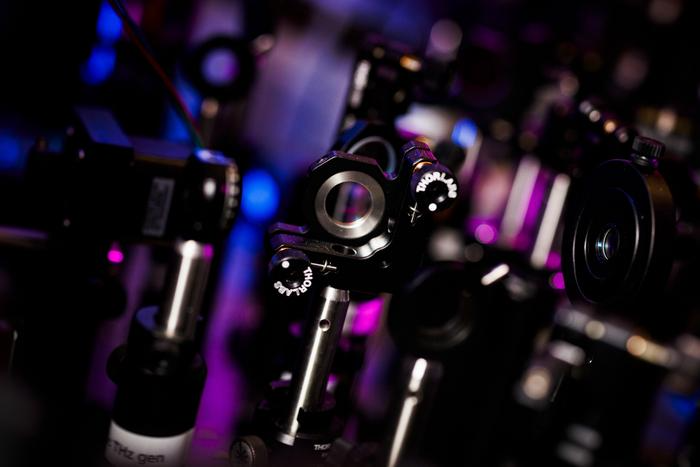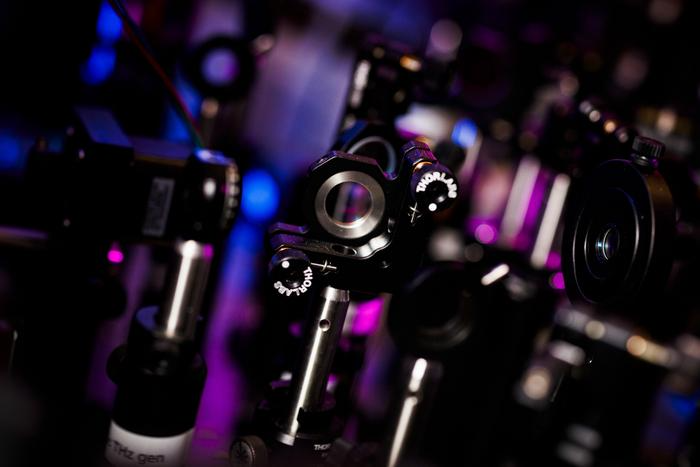Antiferromagnet Magnetized with Light
Antiferromagnets are tricky beasts. On the one hand, researchers love them because the net-zero magnetization of the materials is robust against stray magnetic fields, meaning the materials can be used as highly stable magnetic shields. On the other hand, researchers hate them because the net-zero magnetization of the materials makes it extremely hard to manipulate an antiferromagnet’s magnetic properties. Now Nuh Gedik of MIT and his team have demonstrated a way to use light to crack the magnetic robustness of an antiferromagnet [1]. The team showed that a terahertz light pulse can rapidly switch on a long-lasting magnetic state in an antiferromagnet, opening a potential direction for future magnetic storage devices.
In an antiferromagnet the spins of neighboring atoms point in opposite directions. If the magnitude of each spin is the same—as is generally the case—this antiparallel alignment results in a net-zero magnetization, as the magnetic fields of the up and down spins cancel each other out. The alignment of the spins is very robust to perturbation from stray magnetic fields, making antiferromagnets a potential candidate for future information-storage devices. But to achieve that goal, researchers need a way to reliably control the magnetic state of antiferromagnets, for which methods were previously lacking. “The no net magnetization is a blessing and a curse,” Gedik says.
In their experiments the researchers illuminated a film of the antiferromagnet iron phosphorus trisulfide with terahertz pulses of light. The frequency of the light was tuned to a low-energy vibration mode of the atoms, allowing the team to jostle the positions of the atoms relative to one another. The team showed that this jostling moves the up spins closer together and the down spins farther apart.
Probing the magnetic properties during this shifting process, the team found that it magnetized a region of the sample. This metastable magnetic state lasted 2.5 milliseconds (ms), a relatively long lifetime for such a state. (Light-induced phase transitions in similar systems have previously lived for a few picoseconds, a billion times shorter than the milliseconds achieved by Gedik and his team.)
The explanation for this light-induced magnetization is related to fluctuations in the spin alignments. When the up spins are brought closer together by the illumination, they interact more strongly and fluctuate less, making their time-averaged alignment greater. The opposite occurs for the down spins: weaker interactions, more fluctuations, and smaller time-averaged alignment. The result is a net magnetization since the overall alignments of up and down spins no longer balance out.
The net magnetization state also appears to be coupled to the antiferromagnetic phase transition of antiferromagnet iron phosphorus trisulfide—the transition where the antiparallel ordering of iron phosphorous trisulfide breaks down into a random orientation of spins. The researchers found that the magnetic state was more pronounced as they raised the temperature to where this transition occurs. Gedik says that this effect appears to come from a coupling of the light-induced change in the arrangement of the spins to the phase-transition-induced fluctuations in spin alignment. This coupling may make the spins more amenable to switching into the magnetic state.
As well as the lifetime of the state, the researchers measured the time it takes to switch on the magnetic state. They found a switching time of about a picosecond, 6 orders of magnitude faster than that of most current magnetic storage devices, which use electric signals to “flip” the magnetization in a magnetic material. “The state is fast and slow at the same time,” says Tianchuang “Michael” Luo of MIT, who worked on this study with Gedik. “That we can quickly activate this very stable state is exciting because it could allow us to store information in it for a long time,” he says.
The long-lived lifetime of the state also opens the door to better understanding the properties of the state. For example, 2 ms could be long enough to make electrical measurements of the system, something that isn’t possible for slower-lived states. “Two milliseconds is like an eternity,” Gedik says.
Other researchers have demonstrated light-induced effects in antiferromagnets, but not with the control shown by Gedik’s team. In most previous studies the light coupled to both the atoms’ electrons and their spins. “The light affected every property of the material,” says Batyr Ilyas of MIT, who also worked on this study. The team was able to target just the magnetic properties—a level of control made possible by using terahertz light that interacted only with the spins (through the atom-jostling mechanism).
“This is a well-designed experiment, backed with simulations and modeling to reveal how intense terahertz pulses can modify emergent properties in solids,” says Richard Averitt, who studies the optical and electronic properties of quantum materials at the University of California, San Diego. For Averitt the idea that fluctuations enhance the stability of the photo-induced phase is also particularly noteworthy, he says, as it could be used to manipulate a host of other contemporary quantum materials. “The idea of using light to explore and control or modify the complex energy landscape of quantum matter is very exciting with significant potential for new discoveries.”
–Katherine Wright
Katherine Wright is the Deputy Editor of Physics Magazine.
References
- B. Ilyas et al., “Terahertz field-induced metastable magnetization near criticality in FePS3,” Nature 636, 609 (2024).





